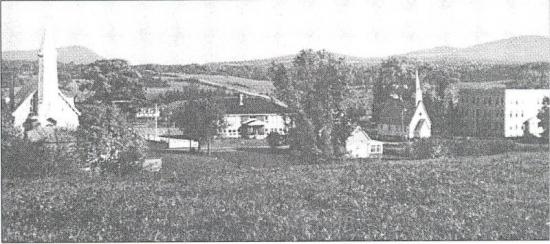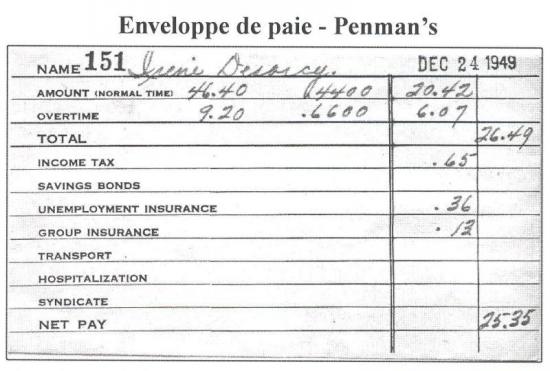
The village of Stanhope (port of entry to Norton, Vt.) can be seen (co-ordinates 45 007"71 48) near the western bank of the Coaticook River, about 40 kilometers from Sherbrooke. This village was first known Boundary Line. A particular feature of Stanhope is the fact that the village territory is shared between the Municipality of Dixville and the Municipality of Coaticook(1). It is also, for anyone wanting to be more aware of certain political considerations, a part of St. Francis and Mégantic-Compton. The first settlers arrived here around 1853, with the coming of the railroad.
The post office, under the management of the post master, M.A. Murry, was opened in 1860 under the name of Stanhope in honour of Philip Henry Stanhope,
511) Earl Stanhope(1805-1875),
politician and a British historian better known as Lord Mahon.(2)
There were approximately a dozen families living in the village this time. Richard Dwyer was one of the first settlers and he worked for the Grand Trunk Railroad . The Rev. George Brown celebrated the first mass in Mr. Dwyer's home on December 8, 1860.
Masses were held in an old railroad station until the first chapel was built in 1866. Moreover, it was in this chapel that the Rev. Alphonse Gravel celebrate the first mass held here on January 20,1867.
Stanhope grew quickly and by 1867, as well as the railway station, there could be found a sawmill, a post office, a granite quarry and three stores: Perkins & Fletcher, Parker & Remick and Mason & Bollet.
There were approximately 75 families of which 60 families lived in the village of Stanhope and Norton, Vt. According to a census reading, by the spring of 1869. The other families lived on the surrounding farms.
Lydia C. Andrews, author of the book, "Three towns", stated that the Customs Office in 1871 was located in the home of David Young who was the first custom's & collector. This building is today the property of Phillipe Aubert and Mrs. Marie Dion.
The first priest to live in Stanhope was Abbé Louis Ferdinand Coderre and he arrived December 1, 1875.
In 1878, the post office could be found in a building adjacent to the Nelson Store.
In 1887, Abbé Amédée Goyette was assigned to Stanhope. The parish of Sainte-Suzanne began on December 25`h of this same year. It was noted in the Official Gazette October 18. 1890 that the formal name of the parish was Sainte-Suzanne de Boundary Line.
The Sainte-Suzanne Boundary Line School Commission was founded June 27,1891 according to the Official Gazette. This notation may be found on page 1626.
Abbé Goyette had requested sisters of the faith to come and educate the children and in 1903 three nuns arrived by train. These nuns had come from the Présentation de Marie Convent in St-Hyacinthe. Shortly after these sisters arrived, they began the school know as St-Paul's. This school would continue until 1955. As well the sisters ran the boarding school of Notre-Dame des-Neiges until it was designated for demolition in the fall of 1971.
In 1908 the office of Canada Customs was located closer to the American Customs.
In 1915, the church of St Suzanne was built in a matter of only eight months.
In 1922, an enlargement of the convent was begun. This building had served as a distillery at one time, a hotel, and a store before finally becoming a school house.
In 1928, the Norton Electric Light Plant installed electrical line to furnish the village with electricity.
The granite quarry belonging to Antoine Gingras, in competition with the Bussière Quarry, opened in 1933 and was in operation until 1960's.
His Grace Phillipe Desranleau read a solemn blessing during the dedication of the monument 'Bonne Entente" and over 3,000 persons attended the event. Among the invited guests were the following: George Aiken, Govenor of Vermont, and the Honourable John S. Bourque, Minister of Quebec Public Works who represented the Honourable Premier of Quebec, Maurice Duplessis.
In 1947, the Norton Baptist Church which had been built of the Nelson family, was taken apart and moved to a site on Baldwin St. in Coaticook. This building presently belongs to Emile Provencher.
In 1957, the opening took place at the new custom's offices.
The opening of the village school took place on October 14, 1962 with an official blessing presided over by his Grace Napoléon Loiselle.
On August 10, 1966, a second church by the name of St-Paul's was moved to Dixville where it can still be seen today. It is used by the residents of the "Dixville Home".
In October 1973, the last chicken supper was held. These suppers benefitted the local parish activities.
The Comité de Loisir was formed with much enthusiasm in 1984. They built a playground and a park for the village under their tenure.
The Centennial Anniversary of the parish was celebrated in 1989. Following this, on September 25, 1997, the parish of Sainte-Suzanne closed.
This was a brief history of the village of Stanhope.
(1) (2)Names and Place Names of Quebec, Toponymy Commission-1994 Three towns-1986-Lydia C. Andrews



